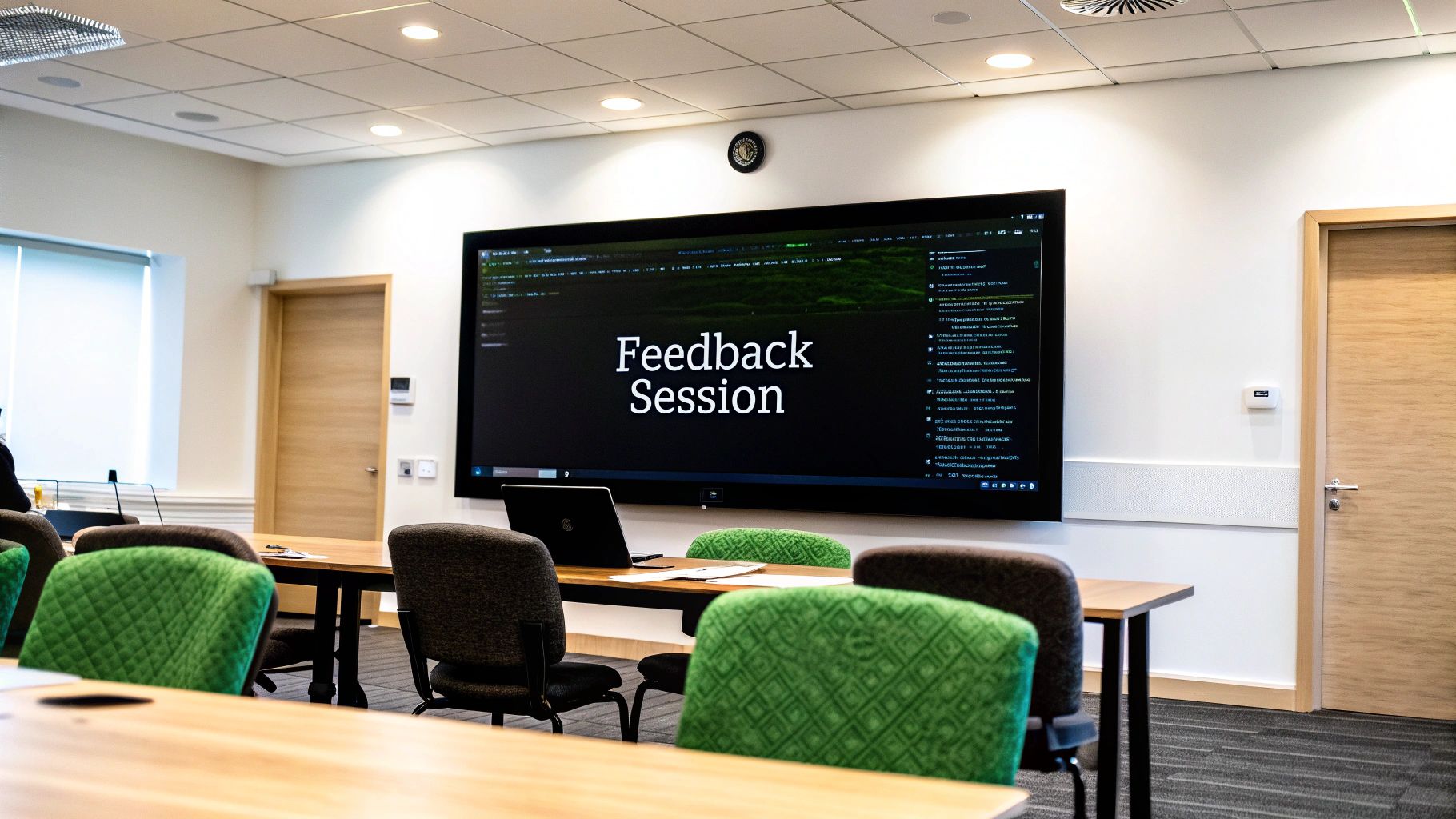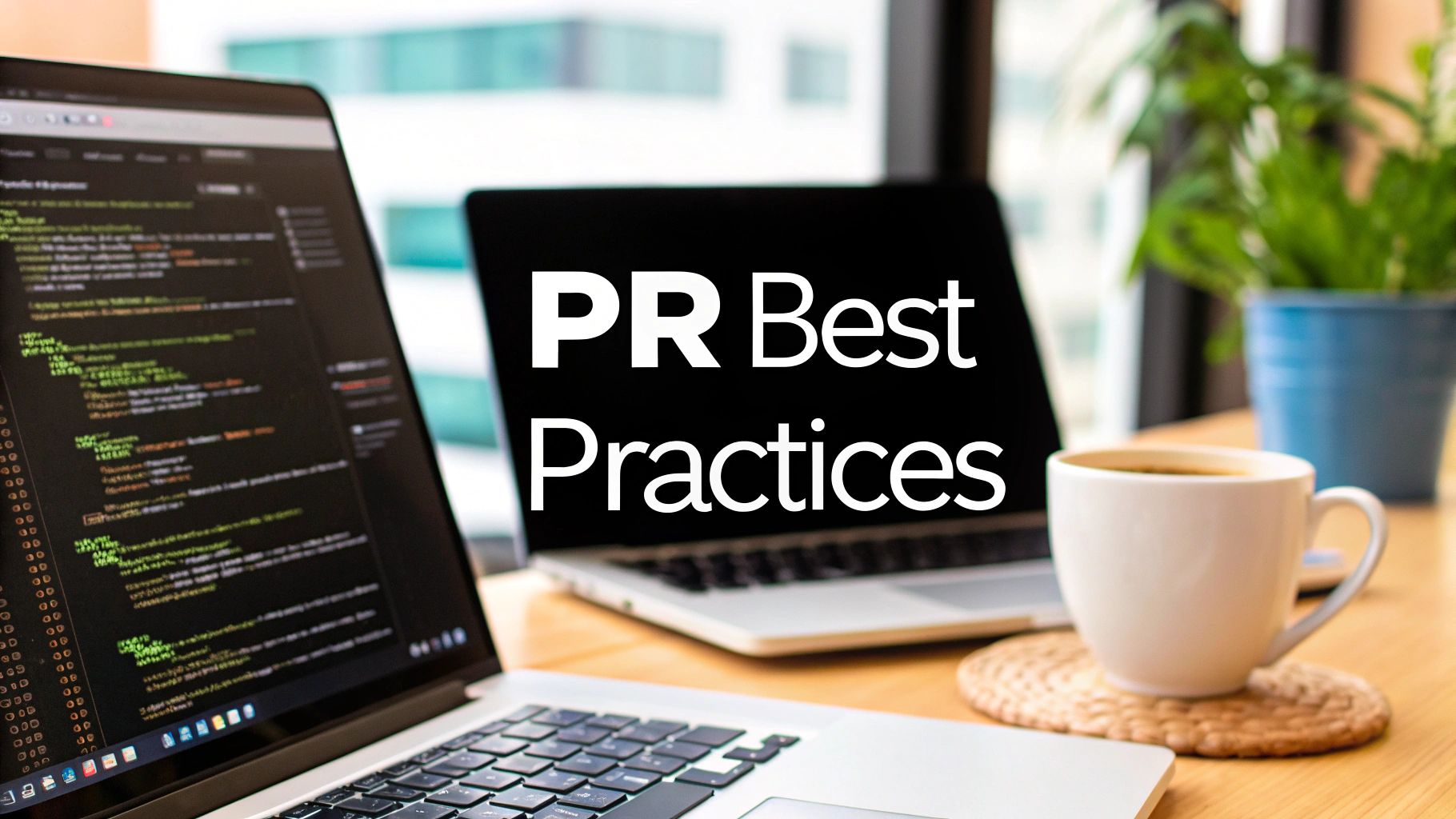Essential Pull Request Best Practices: A Complete Guide for Development Teams
Understanding Pull Request Size and Impact

The size of pull requests (PRs) makes a real difference in how efficiently teams can review and ship code. Think about reading code like reading text - a focused 2-page article is much easier to digest than a dense 50-page chapter. Small, focused changes let reviewers give better feedback faster. Let's explore exactly why PR size matters and how it affects your team's results.
Why Smaller Pull Requests Are Better
Small PRs speed up the entire development cycle. When changes are contained and focused, reviewers can quickly understand the context and provide meaningful feedback. This leads to faster iterations and more frequent feature releases. Finding bugs also becomes much simpler - a issue in 50 lines of changed code is far easier to pinpoint than one buried in 500 lines.
Research shows that keeping PRs small directly impacts productivity. Teams that maintain pull requests under 50 lines of code ship 40% more code than those dealing with 200+ line changes. Smaller PRs also make it easier to write targeted tests and roll back problematic changes when needed. Learn more about PR best practices How to master sitemaps
Strategies for Managing PR Size
The key to handling large changes is breaking them into independent, manageable pieces. Look for natural boundaries in the feature where you can split the work. For example, separate the database changes, backend logic, and frontend updates into different PRs. Even small refactoring or configuration changes deserve their own focused PRs rather than being bundled with feature work.
Measuring and Optimizing PR Size
Track metrics like average PR size and review time to spot bottlenecks in your process. Look at the data - are certain types of changes consistently larger? Do some components generate more complex PRs? Use these insights to adjust how you break down work. Make changes based on what the numbers tell you, like splitting up PRs that grow too large or identifying patterns that lead to oversized changes. Regular monitoring helps maintain an efficient review process that keeps code quality high.
Streamlining Your Code Review Process

Good code reviews are essential for building better software and helping teams work well together. While finding bugs is important, the real value comes from creating a process that makes the whole team stronger. Let's look at proven ways teams can make their code reviews both efficient and collaborative.
Understanding Review Dynamics
The size and scope of a pull request greatly affects how it should be reviewed. Small bug fixes may only need a quick check of the changed code. But major architectural changes require deeper discussions about design choices and how they might impact other parts of the system. By matching your review approach to the PR's scope, you'll use everyone's time more effectively.
Effective Feedback and Constructive Discussions
How you give feedback shapes how well it's received and used. Focus on the code itself rather than the person, and frame suggestions in a helpful way. Instead of "This is wrong," try "What if we did it this way to make it clearer?" This approach leads to better solutions since people feel comfortable having honest discussions about improvements.
Frameworks for Structured Reviews
Using tools like Pull Checklist helps teams review code consistently and thoroughly. Checklists make sure reviewers check all important aspects like functionality, security, and coding style. This organized approach is especially helpful for complex changes where it's easy to miss details. It also helps new team members learn the ropes faster by giving them clear guidelines for good reviews.
Balancing Thoroughness and Speed
The amount of code in a pull request directly impacts review quality. Studies show review time doubles when PRs grow from 100 to 200 lines of code. Larger PRs also make it harder to spot bugs. See best practices for pull requests. Top teams keep PRs under 400 lines when possible by breaking big features into smaller chunks. This lets them give each change proper attention while maintaining good development speed.
Measuring and Optimizing PR Performance

Getting the most out of your pull request (PR) process requires paying attention to how your team actually uses them. Rather than just going through the motions of creating and merging PRs, look at what the data tells you about your workflow. When you analyze this information carefully, you can spot problems and make smart adjustments to help your team work better.
Key Metrics for PR Performance
To really understand how well your PR process works, you need to track specific numbers that matter. These measurements give you a clear picture of team performance and show where you can make things better. Here are the essential metrics to watch:
- PR Cycle Time: How long it takes from creating a PR to merging it. When this number goes down, it means your development is moving faster.
- Review Time: The average time reviews take. This shows if reviews are becoming a bottleneck.
- PR Size: How many lines of code change in each PR. Keeping PRs smaller usually means easier reviews and fewer mistakes.
- Number of Reviewers: The typical count of people reviewing each PR. This affects both speed and quality.
- Merges Without Reviewers: How often PRs get merged without proper review. This helps catch potential quality issues.
By keeping an eye on these numbers, teams can see exactly how they're doing and what needs work. For example, if your PRs are regularly very large, it might be time to break work into smaller pieces. This leads us to making sense of all this data.
Interpreting the Data and Taking Action
Having numbers is just the start - you need to understand what they mean for your team. For instance, if reviews consistently take a long time, maybe your reviewers have too much on their plates or the PRs themselves are too complex. Looking at created, merged, and declined PRs shows how work flows through your system and where things might get stuck. You can learn more about tracking these stats here: Pull Request Statistics: What, Why, and How to Find in Bitbucket.
Don't forget to ask your developers what they think too. Sometimes the best insights come from conversations about what makes reviews difficult or slow. Looking at both numbers and feedback gives you the full story.
Implementing Measurement Systems
Setting up PR tracking doesn't have to be complicated. Start by picking the metrics that match what your team wants to achieve. Tools like Pull Checklist can track these numbers automatically - check out our guide about How to Master Sitemaps. Add these tools to your current workflow so collecting data becomes natural and easy. Make time to look at the numbers regularly and adjust how you work based on what you learn. When teams get used to checking and using this data, they make better decisions about how to improve their PR process.
Crafting Clear and Effective PR Descriptions

Creating an effective pull request (PR) description is key to smooth code reviews and team collaboration. A clear description helps reviewers understand both the changes and reasoning behind them, which speeds up reviews and improves code quality. Let's explore how to write PR descriptions that truly help your team understand and evaluate code changes.
Essential Elements of a Great PR Description
Every strong PR description needs a few core components to give reviewers the full picture. These elements provide the vital context that helps reviewers quickly grasp what you've changed and why.
- Context and Purpose: Begin by explaining what problem you're fixing or what feature you're adding. Paint a clear picture of why these code changes are needed. This background helps reviewers understand your overall goals.
- Technical Decisions: Share your thought process behind key technical choices. Did you pick a certain approach for performance reasons? Or to make future maintenance easier? Help reviewers see your reasoning.
- Change Summary: Give a quick overview of what files changed and how. Think of this as a roadmap that helps reviewers navigate through your code before they dive in deeper.
Practical Techniques for Documenting Changes
Good documentation goes beyond just listing what changed. You need to explain impacts, provide context, and guide reviewers through your thinking process.
- Use Descriptive Commit Messages: Write clear, specific messages for each commit that explain exactly what changed. This helps track how the PR evolved over time.
- Highlight Key Changes in the Description: Point out the most important parts that need special attention. This helps reviewers focus on critical areas first.
- Provide Before-and-After Examples: For visual changes, add screenshots showing the differences. This makes it much easier to see the actual impact of your code.
Leveraging Templates and Examples for Consistency
Using PR templates helps ensure every description includes all needed info and follows team standards. These templates make reviews faster and reduce back-and-forth questions. Templates are especially helpful for keeping descriptions consistent across large teams.
- Create Templates for Common PR Types: Make specific templates for bug fixes, new features, and other common changes. This ensures you capture all relevant details every time.
- Include Examples in Your Templates: Add sample text showing how to fill out each section. Clear examples help everyone write better descriptions.
By following these best practices for pull requests, teams can create smoother code reviews that lead to better quality code and faster releases. Tools like Pull Checklist can help automate and standardize your PR process through GitHub integration.
Leveraging Automation and CI/CD Integration
Good pull request (PR) workflows help teams catch bugs early, ensure quality, and move quickly. The key is integrating Continuous Integration/Continuous Delivery (CI/CD) systems to automatically validate code before it ships. When implemented thoughtfully, automation helps teams focus on what matters most.
Automating Checks and Validations
For code review to scale effectively, configure automated checks to catch common issues upfront:
- Code Style & Formatting: Tools like linters and formatters ensure consistent style, making code easier to review and maintain
- Static Analysis: Detect potential bugs, security issues, and code quality problems before they cause problems
- Unit Tests: Verify individual code components work correctly in isolation
- Integration Tests: Confirm different parts of the system work together properly
By catching routine issues automatically, reviewers can focus on architecture, maintainability, and business logic rather than style nits and simple bugs.
Building Robust CI/CD Pipelines
Connect your CI/CD pipeline to trigger automatically when pull requests are created. This provides fast feedback on whether changes pass all required checks. For example, if unit tests fail, the developer gets notified immediately and can fix the issue while the code is still fresh. CI/CD can also deploy changes to testing environments so reviewers can validate the changes in a real setting.
Identifying Valuable Checks and Interpreting Feedback
Choose automated checks carefully based on what provides the most value for your team. Unit tests and integration tests often provide the highest return by finding real bugs. Style checks help maintain consistency but may matter less than functional testing. When checks fail, take time to understand root causes - examine logs, reproduce locally, and discuss with teammates to find good solutions. This helps everyone learn and improve over time. The goal is building a feedback cycle where automation helps developers write better code.
Building a Collaborative PR Culture
Creating a strong pull request (PR) culture is key for any successful engineering team. Code reviews should be more than routine quality checks - they're valuable opportunities for learning, mentoring, and helping the whole team improve. When done right, PRs strengthen relationships and spread knowledge across the team.
Fostering Meaningful Feedback and Positive Dynamics
Great PRs start with trust and open communication. Teams need to view feedback as a way to help each other grow, not as criticism. For example, instead of saying "This variable name is confusing," try "Could we consider a more descriptive name like userAccountStatus to make the code clearer?" Small changes in phrasing make a big difference in how feedback is received.
Take time to highlight helpful code reviews. When team members consistently give thoughtful, constructive feedback, recognize their efforts publicly. This shows everyone that good code reviews matter and encourages others to put in the same care and effort. Reviews work best when they feel like a team activity rather than a chore.
Turning PRs into Learning Opportunities
Code reviews are perfect for mentoring and knowledge sharing. Senior developers can explain not just what changes are needed, but why certain approaches work better than others. For instance, they might walk through the reasons for choosing a particular design pattern or security measure. These discussions help junior developers build deeper understanding.
The learning goes both ways - senior developers often gain fresh perspectives from newer team members' questions and ideas. You might be interested in: How to master sitemaps for insights into further enhancing your team's workflow. This exchange of knowledge makes the whole team stronger.
Handling Disagreements Constructively
When team members disagree on code changes, having clear guidelines helps keep discussions respectful and productive. Focus discussions on finding the best solution for the project rather than proving who's right. If the team can't reach agreement, have a clear process for escalating to a tech lead or architect for a final decision. This keeps things moving forward while maintaining good working relationships.
Building Trust Through Transparency
Open communication builds trust in PR discussions. Make sure everyone understands project goals, design decisions, and coding standards. For example, keep design docs and architectural decisions in a shared space where the whole team can reference them. When everyone has the same context, they can give more meaningful feedback. This shared understanding leads to better code reviews and a stronger product.
Boost your team's code review process with Pull Checklist. Get automated workflows, enforce best practices, and build quality into your GitHub pull requests with smart, conditional checklists. Visit Pull Checklist today to learn more.
